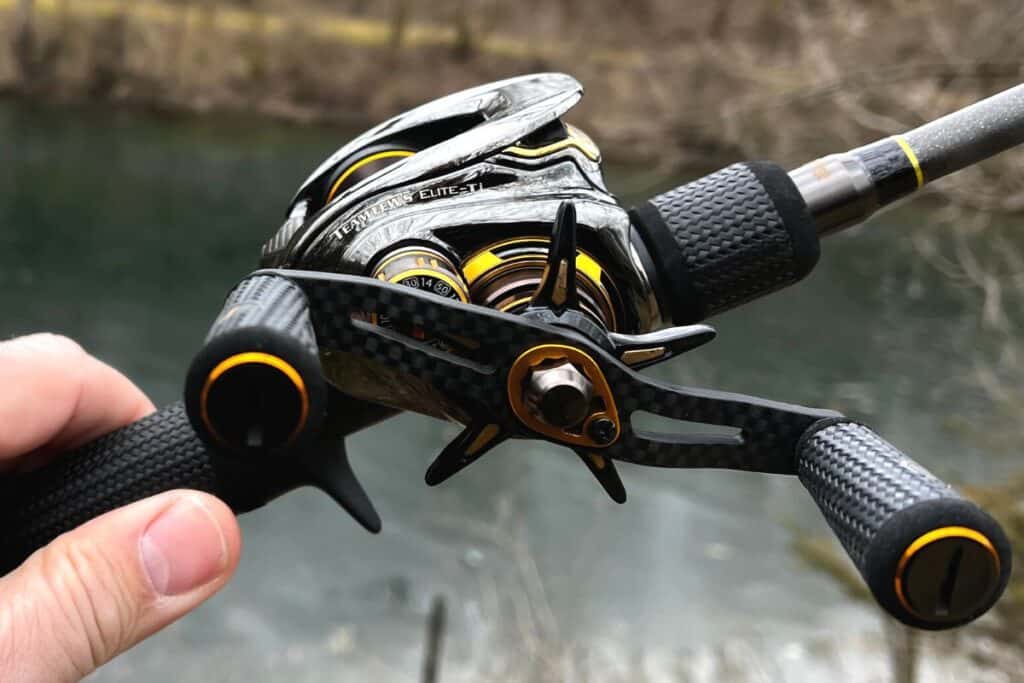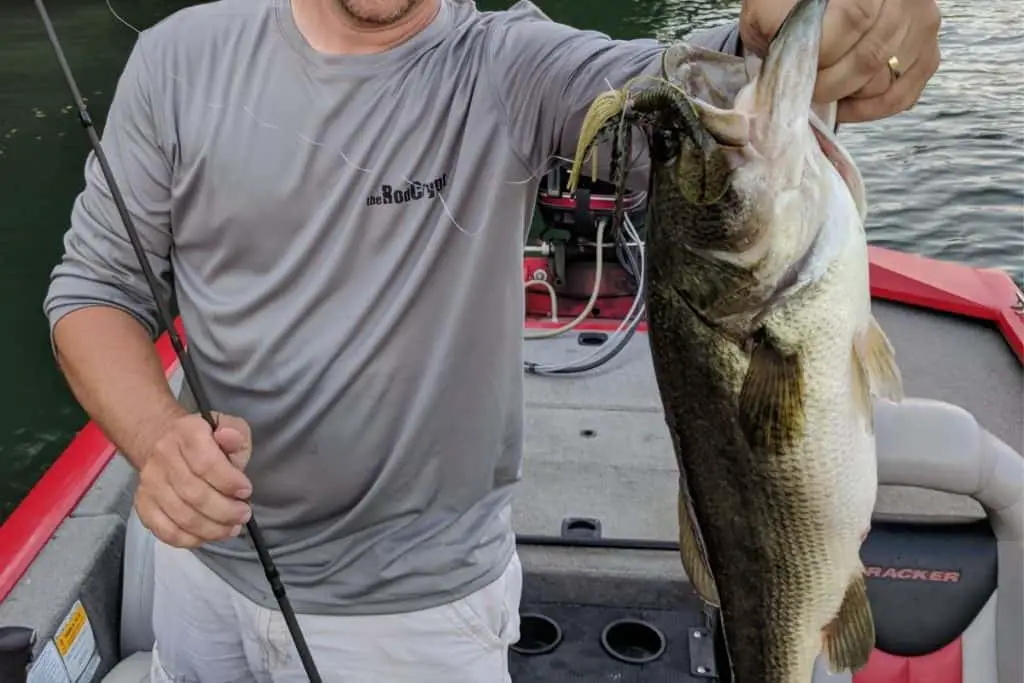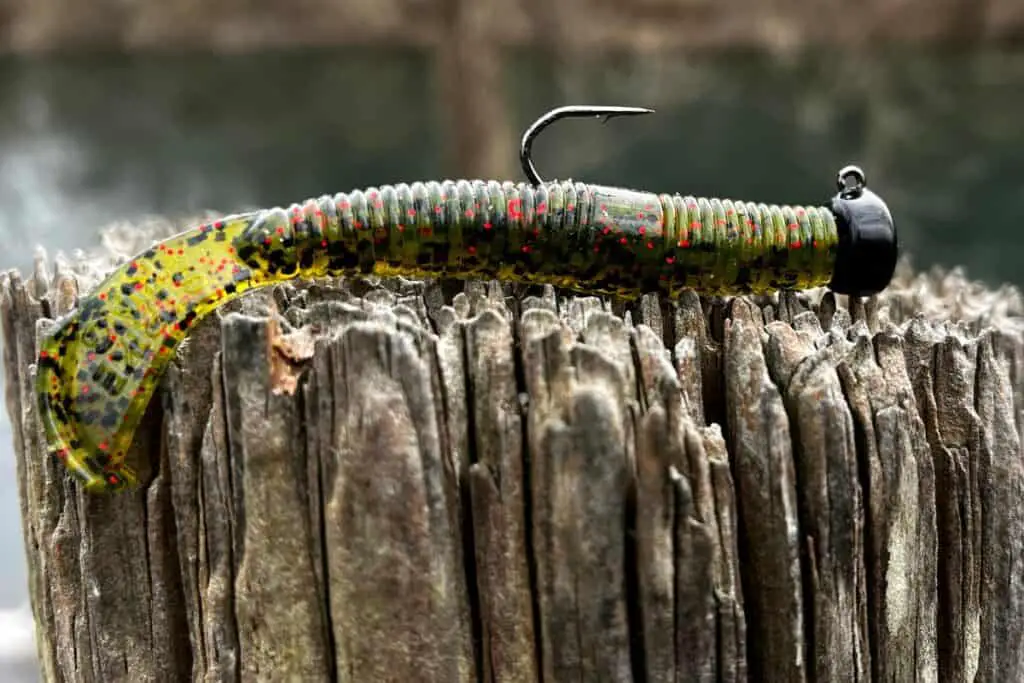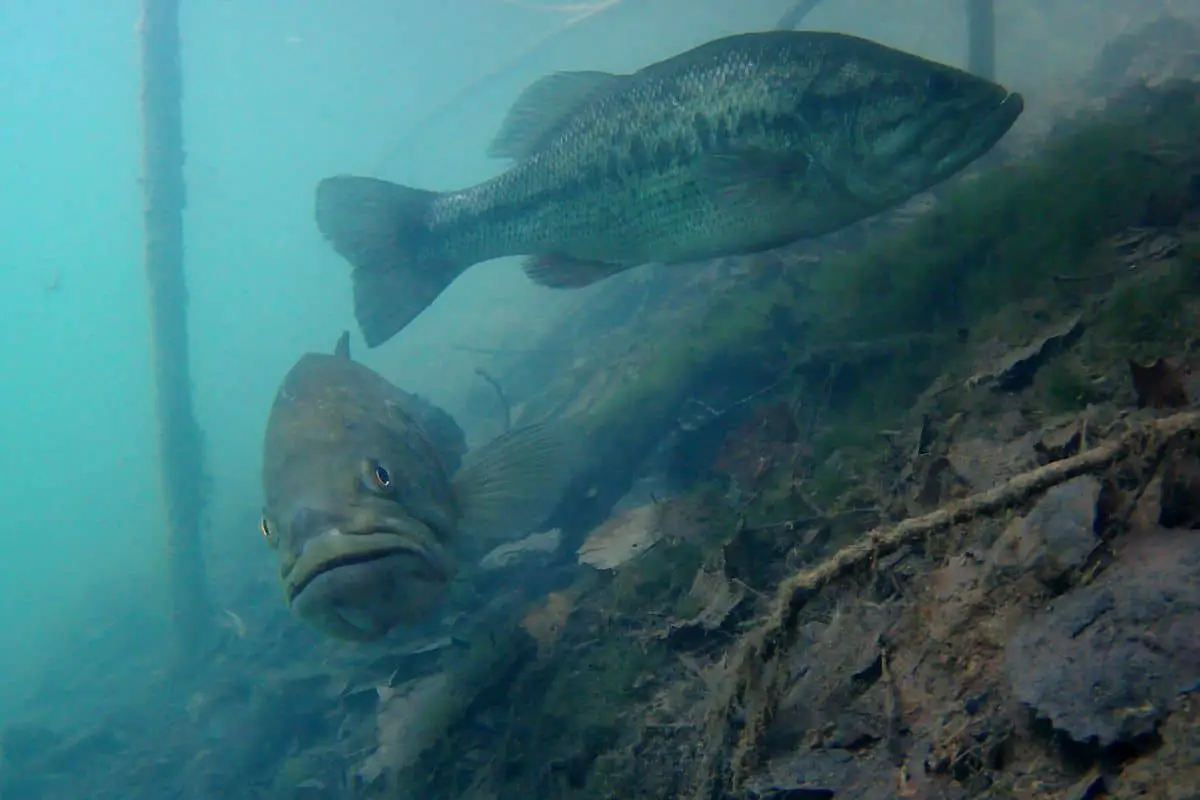Getting a bite is hard enough on most days. Losing a bass after the bite can be frustrating and demoralizing.
Losing bass can be a result of incorrect rod choice, drag setting on the reel, the hookset angle, and finally knot type and hook selection.
Most anglers assume that losing fish is a result of dull hooks. While this can play a part in failing to land a bass, it is last on my list for a reason. It is not nearly as important as the other factors we will discuss.
The Right Rod for the Technique is Critical For Landing Bass
This is by far the number one issue I see and it is often the most overlooked.
There are many different rod types, actions, and power ratings for a reason. Each is tailored to a specific style of fishing. Yes, there are rod ratings that are the most “versatile” and cover a variety of situations, but let me explain what often happens.
Years ago I was fishing out of a canoe in the Boundary Waters near Ely, MN. The smallmouth were aggressive and ate our soft plastic tubes all day. We were using insert tube heads with an exposed hook. The hookup ratio should have been very high for everyone.

My partner was getting a lot of bites like the rest of us, but consistently would swing and miss. Our group would land 10-15 fish and maybe this other angler would land one.
Same lure. Same location. And the smallies were eating everything.
I started to watch him more carefully trying to help. He was very frustrated and didn’t know why this was happening.
Then I noticed the problem. This angler was using a crankbait rod while fishing soft plastic tubes.
A true crankbait rod is composite and has a lot of flex, or parabolic action. This technique-specific rod helps anglers keep tension on the bass after they hit the crankbait, without ripping the treble hooks free from the mouth of the fish. Treble hooks are more of a “grabbing” style as opposed to a true “penetration” hook like a single-point version.
By using this wrong rod for the technique, this angler was getting almost zero energy transferred to the hook point. All of the arm action and energy was absorbed into the extreme bow of the parabolic rod. Therefore the hook never had enough power to penetrate the lip of the smallmouth.
I handed my Medium-Heavy power-rated rod with a fast action to my partner.
He landed the very next bite and never missed a smallmouth the rest of the day.
The below table is an example of rod power rating and action for different techniques and lures.
CASTING RODS
| Style | Power | Action | Length | Line Rating | Lure Rating |
| Jerkbait | MH | F | 6’8″ | 12-25 | 3/8-3/4 |
| Jerkbait | MH | F | 6’10” | 12-25 | 3/8-3/4 |
| All Purpose Reaction | M | F | 7′ | 10-20 | 3/16-1/2 |
| All Purpose Reaction | MH | F | 7′ | 10-30 | 1/4-2 |
| Dock/Skipping/Frog | MH | XF | 7’2″ | 10-30 | 1/4-2 |
| Spinnerbait/Swim Jig/Topwater | MH | XF | 7’2″ | 15-30 | 1/2-2 |
| Flipping/Pitching | H | XF | 7’4″ | 15-30 | 3/8-1 |
| FB Jig/Car Rig/Big Spinnerbait | H | XF | 7’6″ | 15-30 | 1/2-1 1/2 |
| Flipping/Pitching | XH | XF | 7’6″ | 15-30 | 1/2-3 |
| Flipping Pitching | H | XF | 7’10” | 15-30 | 1/2-1 1/2 |
SPINNING RODS
| Style | Power | Action | Length | Line Rating | Lure Rating |
| Drop Shot/Finesse Dock | M | XF | 6’10” | 6-14 | 1/4-1/2 |
| Drop Shot/Ned Rig | ML | XF | 7′ | 6-14 | 1/8-3/8 |
| All Purpose Finesse | M | XF | 7′ | 8-20 | 1/4-3/4 |
| All Purpose/Dock Rod | ML | XF | 7’2″ | 6-14 | 1/8-3/8 |
| Shakey Head/Tube | M | XF | 7’2″ | 8-20 | 1/4-3/4 |
| Smallmouth Special | M | XF | 7’4″ | 8-20 | 1/4-3/4 |
| Smallmouth Special | ML | XF | 7’6″ | 6-14 | 1/8-3/8 |
CRANKBAIT RODS
| Style | Power | Action | Length | Line Rating | Lure Rating |
| Small Crankbaits | ML | M | 6’8″ | 8-12 | 1/4-5/16 |
| Squarebill/ Red Eye Shad | M | M | 7′ | 10-17 | 1/4-3/8 |
| Accuracy Bladed Jig/KVD 2.5 | MH | M | 7’1″ | 12-20 | 1/4-1/2 |
| Medium Crankbaits | MH | M | 7’4″ | 12-20 | 1/4-1/2 |
| Open Water Bladed Jig/KVD 2.5 | H | M | 7’4″ | 12-30 | 1/4-2 |
| Medium to Deep Crankbaits | M | M | 7’10” | 10-17 | 1/4-3/8 |
A rough rule of thumb is a stiffer rod for vertical and bottom bouncing presentations and a rod with a more moderate action and power rating for lures presented horizontally in the water column – or swimming. This is especially true when using lures with treble hooks.
An exception would be using a hollow-body frog in thick slop. In this situation anglers want a heavy power-rated rod to winch those bass from the thick stuff.
(Here is an article on rod selection for beginning bass anglers.)
What is a Good All-Around Rod for a Variety of Techniques?
It is not practical for many anglers to carry around dozens of rods. Not only can it be cost-prohibitive, but it also takes up a lot of space. Shore anglers are even more limited by what they can carry.
So what would be my suggestion for one rod?
The most versatile rod in my locker is a medium-heavy power rating with moderate action. There is still the stiffness to work well with a lot of the single hook techniques like jigs and Texas rigs, but the moderate action offers enough flex at the tip of the rod to assist with those horizontally presented lures like swim jigs and spinnerbaits.
This rod can be used with crankbaits, but anglers still need to be careful to not overpower the rod when they feel a hit on their lure. A true crankbait rod is still the best option if throwing these lures is your number one choice.

Drag Setting on Reels and How it Helps to Land Bass
This may be the most common mistake that anglers make – inadvertently. It has cost me some huge fish and been the cause of major frustration on the water.
The drag on our reels is often the victim of set-it-and-forget-it.
That approach will eventually cost us and it’s not ever going to be a problem with smaller bass. Only the big fish will expose this error on our part.
Here is a perfect example of how not managing my drag properly cost me my personal best largemouth while fishing Lake Toho in Florida.
Being from northern Illinois, I am not used to the potential for a double-digit bass on any cast. A 6-pounder from my area is a huge fish.
I was using a suspending jerkbait and my traditional jerkbait rod and reel. By mid-morning, I had caught multiple two and three-pound fish. Then my rod doubled over and it felt like an anchor was on the other end.
I laid back into it when setting the hook and witnessed a monster bucketmouth boil the water in front of me. Then the worst feeling an angler can experience happened. My rod tip snapped back and the line went limp.
After reeling the lure back in I noticed that the trebles were completely straightened.
This was not because of low-quality hooks.
My lack of ability to land a monster bass was 100% my fault. My drag was set way too tight. It never occurred to me to reset the drag based on the potential of the waters I was fishing. The huge bass needed me to let the drag slip and feed line while maintaining pressure until it was ready to be landed. This was the ultimate hard lesson to learn and I hope I never forget it.
While techniques, like jerkbaits and crankbaits need some slippage from the drag, other techniques are best with the drag set tight.
Pulling bass from thick cover is a perfect example.
When a bass is hooked while buried in the slop or brush, we do not want it to have enough give that the fish can turn and head deeper into the thick stuff. This almost inevitably leads to the bass pulling off. A tight drag in this situation will turn the head of the fish and get it coming to you almost instantly and prevent the cover from assisting to pull it free.

Proper Hookset Angle and How it Helps to Land Bass
There are essentially two types of hooksets that bass anglers need to use.
The first is a side-sweep and the second is a vertical, hard-swinging hookset.
Another way to look at these types of hooksets is by the end result. A side-sweep is meant to allow the rod to load up and maintain pressure without trying to drive the hooks in deeper. A vertical, or upright, hookset is intended to get those heavier-wire hooks to penetrate.
Usually, the side-sweep is used with lures that have treble hooks and the vertical hookset is best suited for single hooks applications like when using jigs and Texas rigs.
The exception is when using finesse presentations with light wire hooks. This could include things like a Ned rig and drop shot. Both of these presentations often are best matched with a more vertical hookset, but not with the intention of driving a hook into the lip of the fish, but with the mindset of maintaining pressure. Those small finesse light wire hooks penetrate easily and if we swing too hard they will straighten.
Understanding the difference between a more subtle “maintain pressure” hookset and a “drive-it-home” hookset will substantially increase your hook-up ratio.
Knot Selection and How it Helps or Hurts Landing Bass
There are many, many styles of knots out there. Learning all of them can be quite a task, but understanding the line we use and how different knots can impact knot strength is critical to avoid breaking off good fish.
Yes, it is important to constantly check your line for knicks and abrasions, but our knots fail more than we realize. This is especially true with fluorocarbon line.
Here is a perfect example of this.
The properties and characteristics of fluorocarbon create a situation where sudden jerks and snaps can cause the line to break instantly with the wrong knot. Any knot where the line tightens into itself on the hookset will often break fluoro.
For example, while a Palomar knot is a great one to use in many situations, it is not a good knot for fluorocarbon when paired with hard hookset techniques. Jigs are Texas rigs are a perfect example.
A better knot when using fluoro with these types of lures is the double-line uni knot. When a hard hookset is used, the line doesn’t close in on itself as it does with the Palomar knot.
Below is a video that goes over this knot and also demonstrates how easily a Palomar knot will break with fluorocarbon and what I like to call “knot shock.”
Hooks and How They Impact Losing Bass
As mentioned earlier, dull hooks do play a part in lost fish, but the above-mentioned factors are more important. By far.
The easiest way to tell how sharp your hooks are is to run the point of them across a fingernail. If the point easily scratches your nail, they are sharp enough. If not, you can always run a fine-tooth file down the hook, away from the point, or change them out.

Light Wire vs Heavy Wire Hooks and Losing Bass
There are pros and cons to each type of hook and knowing where each style excels will drastically improve your hook-up ratio.
Lightwire hooks are designed to penetrate easily, but cannot take hard hooksets or thick cover because they will bend with ease.
Perfect applications for light wire hooks are both finesse presentations and any method that uses a lot of line and distance – like a Carolina rig.
When fishing a Carolina rig, we may have a huge amount of line out. When we feel a bite, a good side-sweep hookset with a light wire hook will penetrate much easier than a heavy wire hook.
Heavy wire hooks excel when used on jigs and Texas rigs in thick cover at a close distance. These hooks require more power to penetrate and will withstand a strong hookset. The heavier wire hooks will also fight their way through cover like thick weeds and wood while not straightening out.
Having a selection of both hook types will allow you to adjust to what the situation and presentation call for.
Good luck out there and be sure to encourage someone today. You never know how you may change their life forever.
Isaiah 6:8

